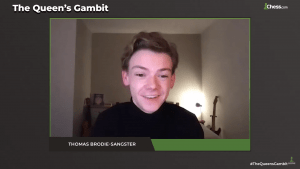
What's Your Favorite Chess Move?
If you were to list your five favorite chess moves, how would you pick them? Would you have to research them, or do you already have them memorized?
When it comes to memory, research suggests that you are more likely to remember a move you've seen many times over a longer period of time (rather than a single game that you played over five hours). You are also more likely to remember moves—whether they are yours or from others—that made an emotional impact on you.

OK, but that's just the memorization part. Science can't as easily account for subjective criteria for "favorites" in artistic endeavors.
Personally, my criteria for favorite moves is actually a single criterion: unexpectedness. Any time a move defies a well-worn path, or breaks a known pattern, it shocks my senses. The science complies—I'm much more able to remember these outlier moves (it probably doesn't hurt that I've used some of these many times in my chess teaching). Maybe for you the fame of the player or the gravitas of the moment matters (I thought about including GM Magnus Carlsen's 50. Qh6+, a move that even shook up mainstream media, but just because he won a world-championship match with a two-mover wasn't good enough for me).
One of the most comprehensive lists of the best moves of all time is Tim Krabbé's basic-looking but content-rich "Chess Curiosities" site. Presumably even he had trouble with a "100 Best Moves" countdown, as he ultimately settled on 110.
If you never been on the site, you're probably scampering there to see what he could have possibly picked as number one. The only move that edged out GM Alexei Shirov's famous endgame bishop sac was GM Boris Spassky's flailing attempt to create counterplay.
Many years before becoming world champion, Spassky must not have thought much of his position in 1956 against GM Yuri Averbakh. Facing a one-sided game, Black unexpectedly ditched a knight, and with it, topped Krabbé's list.
For the record, GM Daniel Naroditsky agrees with Spassky's decision. But according to Krabbé, the late GM Mark Taimanov reacted this way: "I would rather resign the game than to make such a move."
Also for the record, and signifying nothing, both of the GMs involved in the game are still alive (combined age: 177).

It seems that by choosing this over the pantheon of other great players' moves, the Dutch journalist also favors unexpectedness. But, since I could personally never rank this as number one, I guess I'll have to revise my criterion into criteria after all: unexpectedness, but with at least a hint of beauty.
Here are my top five, which are surely not your top five.
Let us know in the comments what you think is the best move ever!
Oops, like Krabbé, I had trouble dwindling my list, so I'll start with an honorable mention for a special reason. I didn't witness any of my actual top-five moves, so I wanted to include the move that was the most unexpected I've ever seen in person. Yes, the fact that it was USA-Russia at an Olympiad probably did contribute.
GM Varuzhan Akobian and I were chatting near the board, with both of us confused that after a rook trade GM Hikaru Nakamura had seemingly given away his final pawn. But then...
Honorable Mention: Nakamura-Kramnik, 2012

GM Hikaru Nakamura sits down to play GM Vladimir Kramnik at the 2012 Olympiad. Make sure to keep those extra knights handy! | Photo: Mike Klein, Chess.com.
Now the real list:
5. A. Petrosian-Hazai, 1970
This game wasn't very noteworthy for 44 moves. A junior tournament in Belgium produced a game where no pawns had been traded and the game was generally devoid of tactics. But with White clearly gearing up for a breakthrough, Black offered his entire queen to maintain the fortress.
I can't think of another position with quite the same idea:
In hindsight, it's obvious, but then, isn't it always?
Extensive analysis has shown White might still be winning by instead going after the a-pawn, but who among us wouldn't take the queen? (It's nice that Stockfish 8 on depth 23 still likes to take the queen.) Also, it is clearly Black's best chance. And, after all, this list is about awesomeness, not objective correctness!
4. Short-Timman, 1991
This is likely the most well-known position from my list. The lovely part is that if Black had realized the plan after the white king's first step, he may have been able to fight back. Instead, the seeming waiting move turns out be the beginning of the most famous king walk in history.
I can't think if any other move or sequence that, upon seeing it for the first time, is guaranteed to leave a smile on a chess player's face.
3. Kamsky-Karpov, 1993
I admit it. I have a strange fascination with quiet moves, which we all know aren't really that quiet. Sac, sac, mate? Yeah, we've seen that a thousand times.
I guess it's no coincidence that four out of the five moves on my list are neither checks nor captures. Three out the five aren't even direct threats, at least not in the traditional sense.
When the best move is one that I would not have even considered, then, yes, Mr. Karpov, you make my list.
Let me know in the comments if you know of any other time that a king move traps a queen that's out in the open. For the record, I'm fairly sure this Caro-Kann setup was called the "Karpov variation" even before this brilliancy in his namesake opening.
2. NN-Karlin, 1933; or Ortueta-Sanz, 1933; or Tylkowski-Wojciechowski, 1931
When I first saw this position, I was amazed at all the extra niceties after the initial move. As a kid, the tactic seemed to keep on acquiring more and more wrinkles the further it went.
I thought surely it must be composed, and studies clearly can't count for this list, otherwise we'd be talking about a whole different kind of unexpected beauty. Turns out, this position, or something very close to it, likely occurred in the early 1930s.
To my mind, it's unlikely to have first appeared as a contrived study, if for no other reason than there's some extraneous pawns on the kingside. The actual players are muddled by the passage of time, but our researcher Krabbé delved deep into the history, as he often does.
Perhaps the game never really happened, so I admit to taking the blue pill on this one. I want to believe that it did.
1. Browne-Bisguier, 1974
I still remember the day that my chess coach showed me this person for the first time. The story goes like this: GM Walter Browne spent 45 minutes on this move, and found it over the board. Bobby Fischer may have known about it according to some speculation, but never got to use it.
This move should also be a mainstay of a chess teacher's arsenal. When I need to kill 15 minutes in a chess class, I have all my students take out paper and pencil and I challenge them that they won't be able to find the right move, even if I let them list 10 guesses each.
To my recollection, none has ever listed the right move. There are just so many other attacking moves and captures to consider!
I love this concept so much that I made a whole Chess.com video compilation about "Stunning Bishop Moves" (Part 1 and Part 2). Just when you thought Browne was done inspiring other brilliancies, it happened again in 2014 just a few months after my videos were published:
So what is your favorite move of all time? Let us know in the comments below!







